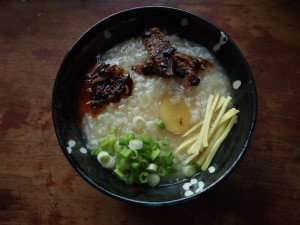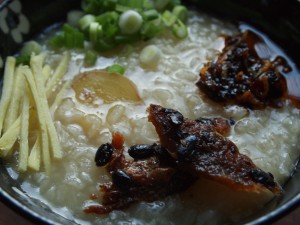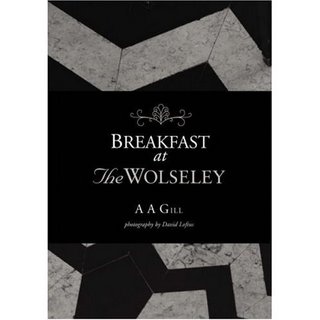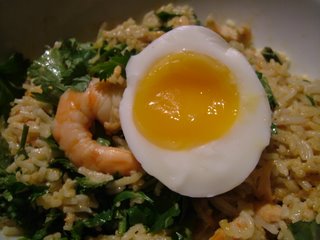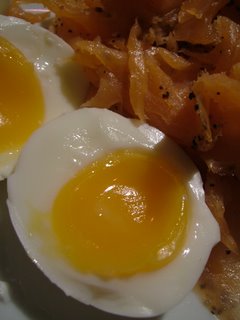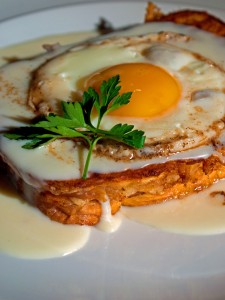
That Béchamel from Tuesday’s post was made with this sandwich in mind. The Croque Madame (literally “Mrs Crunch”, but that sounds considerably less elegant than the French) is one of the world’s great sandwiches, up there with the banh mi, the burger and the pan bagna. The best I’ve ever eaten wasn’t actually in France, but at Thomas Keller’s Bouchon in Las Vegas, where it was made with brioche and served with french fries to mop up the dreamy clouds of Béchamel and egg yolk. This one’s a little different, and makes up for the lack of decent brioche in rural Cambridgeshire by dipping the sandwich in an egg and cheese mixture before frying. Dreadful for the arteries, fantastic in the mouth. Gilding the lily, I served this with sauteed potatoes dressed with truffle oil and Parmesan cheese, and a very sharply dressed salad.
There is more effort involved in this sandwich than there is in slapping together your lunchtime BLT, but it’s absolutely worth it. This is a dish best eaten as part of a lazy Sunday brunch with somebody you love. It’s extremely rich, so that salad’s well worth having on hand to cut through the buttery, cheesy density of flavour. This is, to put it mildly, a bloody marvellous sandwich. Do try making one yourself.
To serve two, you’ll need:
4 thick slices good white bread
4 large eggs
100g Parmesan cheese
200g Gruyere cheese
200g cooked ham, sliced thinly (I like a ham I’ve cooked myself, but a good deli ham is fine here)
2 teaspoons smooth Dijon mustard
2 large knobs butter
50ml (or more, if, like me, you’re greedy) Béchamel sauce
Preheat the oven to 170ºC (340ºF), with a metal pan ready for your sandwiches on a high shelf. Have a pan of warm Béchamel sauce standing by.
Build the sandwiches by spreading the bottom slice with Dijon mustard, layering on the ham, and topping with the grated Gruyere. Put the lid on and give the sandwich a firm squash with the flat of your hand to pack it down a bit.
In a flat dish large enough to take a sandwich, beat two of the eggs with the finely grated Parmesan. Heat one knob of butter in a frying pan big enough to take both sandwiches until it starts to bubble.
Dunk each sandwich in the egg mixture, making sure both sides soak up some of the egg. Slide the sandwiches into the butter and cook for a couple of minutes on each side, until golden. Use a stiff spatula to remove the sandwiches to the heated tray in the oven, and cook for ten minutes to ensure all the cheese is melted.
While the cheese is melting, melt more butter in the pan you fried the sandwiches in, and allow it to bubble away until it is a nutty brown colour (beurre noisette, if we’re being precise here). Fry two eggs in the nutty butter so the white is just set and the yolks runny. Remove the sandwiches to warmed plates, spoon over a few tablespoons of Béchamel, and top each one off with a fried egg.

